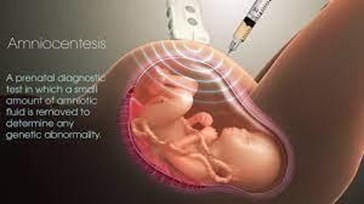A nurse is teaching a client who is at 18 weeks of gestation and is to undergo an amniocentesis. The nurse should explain that the purpose of this test is to identify which of the following? (Select all that apply.)

"Gender of the fetus"
"Anomalies in fetal chromosomes"
"Rh incompatibility"
"Cephalopelvic disproportion"
"Neural tube defects"
Correct Answer : B,E
Choice A: Amniocentesis is not primarily performed to determine the gender of the fetus. The main indication for this procedure is to detect genetic abnormalities or chromosomal disorders.
Choice B: The primary purpose of an amniocentesis is to detect chromosomal abnormalities such as Down syndrome (trisomy 21), trisomy 18, and trisomy 13, among others.
Choice C: Rh incompatibility is assessed through blood tests, not amniocentesis. It involves determining the Rh factor of the mother's blood and monitoring for potential Rh sensitization.
Choice D: Cephalopelvic disproportion refers to a situation where the baby's head is too large or the mother's pelvis is too small to allow for a vaginal delivery. It is not related to amniocentesis.
Choice E: While detecting neural tube defects can be done through amniocentesis, it is not the primary indication for the procedure. Neural tube defects can also be screened for through blood tests and ultrasound examinations. Amniocentesis is more commonly used for chromosomal analysis.
Nursing Test Bank
Naxlex Comprehensive Predictor Exams
Related Questions
Correct Answer is A
Explanation
Choice A: Variable decelerations on the fetal heart rate monitor tracing are suggestive of umbilical cord compression. These decelerations are often V, U, or Wshaped, and their onset, depth, and duration can vary. They are associated with cord compression, which can reduce blood flow to the fetus during contractions. Other options are as follows:
Choice B: Late decelerations are indicative of uteroplacental insufficiency and are not related to umbilical cord problems.
Choice C: Accelerations are reassuring and suggest a responsive, healthy fetus.
Choice D: Early decelerations are usually benign and result from head compression during contractions, not umbilical cord issues.
Correct Answer is A
Explanation
Choice A: The client should not lie on her back during the NST because the supine position can compress the vena cava and reduce blood flow to the placenta and the baby. The NST is typically done with the client in a semireclined or left lateral position to ensure optimal blood flow to the baby.
Choice B: Monitoring the baby's heart rate is a correct statement and a standard part of the NST procedure.
Choice C: The duration mentioned (20 to 30 minutes) is accurate for the average NST timeframe.
Choice D: Scheduling the NST when the baby is usually active is also a correct statement, as fetal movement during the test is an important aspect of evaluating fetal wellbeing.
Whether you are a student looking to ace your exams or a practicing nurse seeking to enhance your expertise , our nursing education contents will empower you with the confidence and competence to make a difference in the lives of patients and become a respected leader in the healthcare field.
Visit Naxlex, invest in your future and unlock endless possibilities with our unparalleled nursing education contents today
Report Wrong Answer on the Current Question
Do you disagree with the answer? If yes, what is your expected answer? Explain.
Kindly be descriptive with the issue you are facing.
